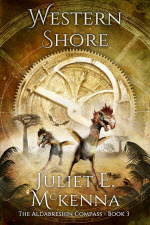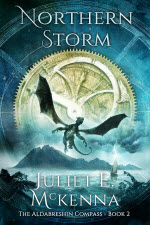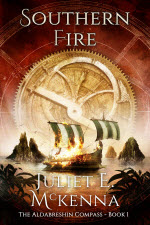Juliet E McKenna is a British fantasy author. Her debut, The Thief's Gamble, appeared in 1999 followed
by 14 further novels. She also writes diverse shorter fiction, reviews for web
and print magazines, teaches and comments on book trade issues. Currently exploring
new opportunities in digital publishing, she’s re-issuing her backlist in
association with Wizard’s Tower Press. This week sees the ebook publication of
Eastern Tide, final volume of The Aldabreshin Compass. Find out more at www.julietemckenna.com
Juliet has dropped by to talk about the women of the Aldabreshin Compass
Silk Gowns and
Bejewelled Glamour – The Women of the Aldabreshin Archipelago
As anyone who’s heard me talking about – or demonstrating –
practical fighting skills at SF conventions will know, I have no patience with
the notion that women cannot be capable warriors in epic fantasy, or indeed
anything else they put their minds to, from merchants to monarchs. Claims that
women in imaginary secondary worlds must lead timid, trammelled lives because
that’s ‘historically accurate’ get equally short shrift from me. There are
countless real world examples to contradict this in every culture and period.
Yes, these were remarkable women – but so were the great men whose deeds are
praised in every history book that leaves women out. Consequently the female
characters in The Tales of Einarinn
absolutely make their own choices and make a whole lot of things happen, from
Livak, gambler and thief, through Halice, captain of mercenaries, to Mellitha,
powerful and wealthy magewoman, to name but a very few.

So what about the women in the Aldabreshin Archipelago?
Because they are very different indeed. Everyone on the Einarinn mainland knows
that. They’re painted, pampered ornaments decorating an all-powerful warlord’s
household and bearing his children. Each domain’s ruler will have three, four
or more wives at his beck and call, to gratify his every lust. If he’s feeling
particularly generous, he’ll offer their sexual favours to other men. In
between times, these women, caged like songbirds, are guarded by armed men, relieving
their boredom with idle pastimes like gambling. Everyone knows that.
Seriously? I’m really writing women who are no different to
the passively distressed damsels who’ve so irritated me in fantasy fiction? The
ones wholly defined by their relationships with plot-central men, and whose
main function is to end up as the hero’s reward in bed in the final chapter,
often after a series of implausible, plot-convenient escapes from rape?
Hardly! As Ryshad discovers in The Swordsman’s Oath, and as I
was able to explore far more fully in The Aldabreshin Compass series, “what
everyone knows” in Einarinn is just as likely to be biased and ignorant as it
is in real life.

Yes, these women do wear flamboyant jewellery and lavish silk
gowns. Since they’re the ones who manage all trade in the Archipelago, that’s a
display of their prowess in the complicated barter system of that cashless
economy. They certainly do favour extravagant, dramatic cosmetics – because
that makes their faces so much harder to read in the midst of tense
negotiation. Any warlord would be very ill-advised to think he could manage his
domain’s commerce any better than his wives who build complex networks of
friendship and obligation with the women married to other warlords. They are
constantly writing letters to each other as well as using merchants and
couriers as their eyes and ears over the length and breadth of this vast island
chain.
Okay, but what about the sex? Yes, these women do sleep with
men other than their husbands, but that’s only ever at their own wish. Why
would they want to? Well, a warlord’s wives are certainly expected to provide
children to secure the next generation’s rule over the domain. What happens if
a warlord is sterile, or gay or cannot have children for some other reason?
What if the existing ties of blood and friendship between allied domains lead
to a strategic marriage between two people who are unhealthily closely related?
Then an Archipelagan noblewoman will choose someone else to father her
offspring and no one else will have a say in the matter. And Archipelagan women
do enjoy sex for its own sake. Why wouldn’t they? The Aldabreshi have
sufficient practical knowledge of herbal and barrier contraceptives to limit
unwanted pregnancy.

A warlord will gratefully raise the children his wife
provides for him while the armed warrior-slave always at her side and
answerable only to her, will make sure no one gets a chance to force himself on
her. Not even her husband, if she decides he’s banished from her bed. An
Archipelagan has no say if his wife decides to divorce him either. Some noblewomen
move from domain to domain, using their trading acumen to win ever more wealth
and influence. Those who’ve proven themselves doing deals as minor wives and
daughters will be assiduously courted by warlords offering them higher status
and greater scope for their talents, for the sake of the resources they can win
for a domain.
So this is a very different vision of female power to that
wielded on the mainland by women who take on the same occupations as men and do
those things just as well. Archipelagan men and women have distinctly different
and defined roles in society that complement each other rather than
overlapping. Crucially, neither is subordinate to the other.
But isn’t this complete fantasy? Even for a secondary world
where authors really could and arguably should be bolder in imagining cultures
without the burdens of our own historical inequalities and bias? Actually, no,
it really isn’t. In creating the very different lives of Aldabreshin women, I
drew on real world examples of both individuals and cultures from times and
places as far afield as Polynesia before Europe’s voyages of discovery and
archaic Persia. There’s precedent for everything I use, up to and including the
sexual freedom these women enjoy.
Of course this isn’t to say these women live idyllic lives.
But the challenges and perils for female characters in The Aldabreshin Compass
series stem from the actions and characters of those who surround them, for
good and ill, in exactly the same way as such things arise for the men. What
are those demands and dangers? You’ll have to read the books to find out.
Many Thanks to Juliet for the post - do please go check out her books here


No comments:
Post a Comment